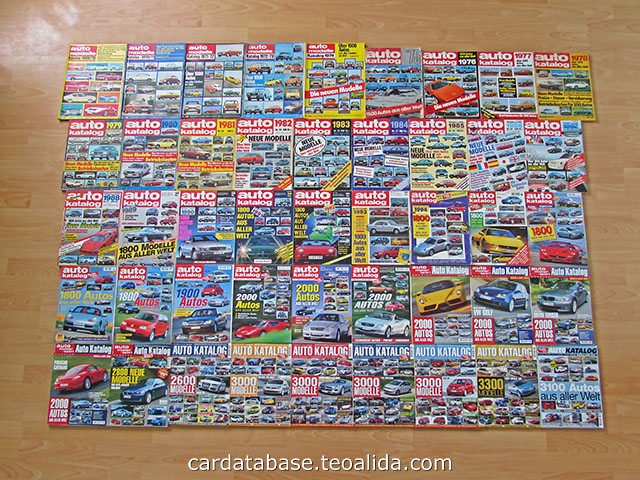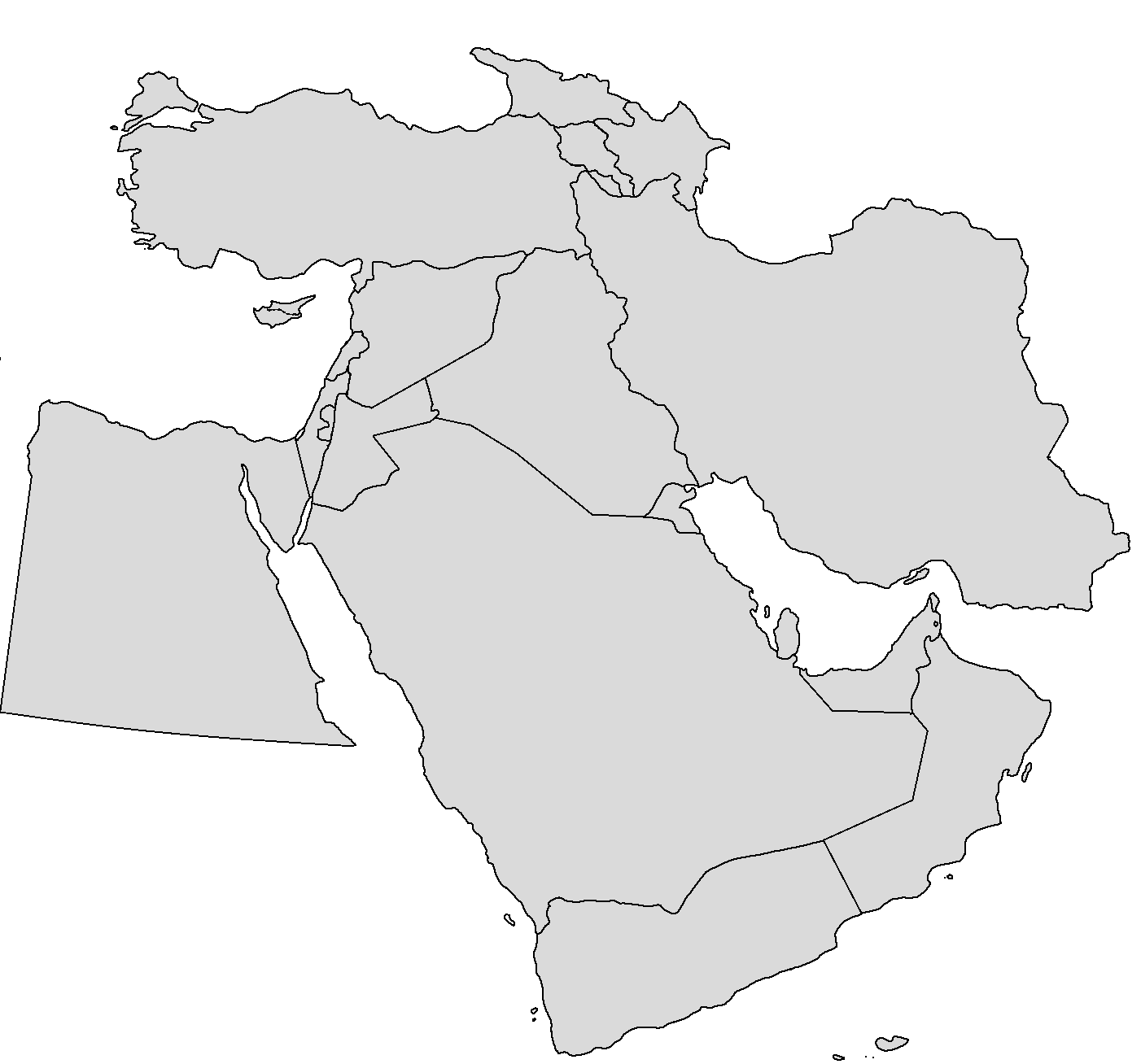The biggest of the “legacy” handmade databases started in 2003, I spent over 1000 hours typing data from AutoKatalog car magazines into computer.
Last update: May 2019, including 564 model versions launched in 2018 and 190 model versions launched in 2019 (changelog).
Customers who bought this database and need updates with new cars are eligible for 50% discount to buy German car database or UK car database.
Download SAMPLE:
Car models, engines, transmission, drivetrain, tires, dimensions, weight, performance, etc (Excel)
Alternate formats: CSV and SQL
Buy complete database:
Coverage
Car sold in Europe. AutoKatalog (german car magazine) have 100% coverage for cars sold in Germany which is the biggest car market of Europe. 99% of cars sold in any European country are also sold in Germany. I also added unique cars sold only in UK, communist cars sold only in Eastern bloc, as well as special cars with 2.0 liter engine to comply with Italian tax system.
If you are outside Europe, you can check list of car models included in Excel file and report missing models (sold in your country but not in Europe) so I can add their data if available, but I cannot guarantee that I can add all.
Source of data: primarily AutoKatalog, one of most reputable car publications in the world, published in Germany since 1957 until 2014, ADAC since 2014 to present, Wikipedia for some pre-1970 cars.
List of car makes included
Mainstream makes: AC Cars, Alfa Romeo, Alpine, ARO, Asia Motors, Aston Martin, Audi, Austin / Rover, Autobianchi, Bentley, BMW, British Leyland (Austin, MG, Mini, Morris, Riley, Rover, Triumph, Vanden Plas, Wolseley), Buick, Cadillac, Chevrolet USA, Chrysler USA, Chrysler Europe / Simca / Talbot (France) / Sunbeam / Hillman / Talbot (UK), Citroën, Dacia, Daewoo / Chevrolet Korea, Daihatsu, De Tomaso, DeLorean, Dodge, Ferrari, Fiat, Ford Europe, FSO, GAZ (Volga), Honda, Hummer, Hyundai, IFA (Trabant, Wartburg), Infiniti, Innocenti, ISO, Isuzu, Iveco, Izh, Jaguar, Jeep, Kia ,Lada, Lamborghini, Lancia, Land Rover, Lexus, Lotus, Maserati, Maybach, Mazda, Mercedes, Mini, Mitsubishi, Morgan, Moskwitch, Nissan, Oltcit, Opel / Vauxhall, Otosan, Peugeot, Pontiac, Porsche, Proton, Reliant, Renault, Rolls-Royce, Saab, Samsung, Santana, Seat, Skoda, Smart, SsangYong, Subaru, Suzuki, Tatra, Tesla, Tofas, Toyota, TVR, UAZ, Volkswagen, Volvo, Zastava, ZAZ.
Bonus minor makes: Artega, Bitter, BMW Alpina, Bristol, Bugatti, Caterham, Cizeta, Donkervoort, Felber, Fisker, Ginetta, GTA Spano, Gumpert, Isdera, Jensen, Koenigsegg, LuAZ, Lynx, McLaren, Messerschmitt, Monica, Monteverdi, Pagani, Panther, Saleen, Venturi, Wiesmann, ZIL (producing less than 100 cars per year).
List as September 2017. Additional minor makes may be added in the future.
Data fields included
Database contain over 60 columns, listed here together with the period that include data in. Completion is nearly 99% for every column for the period covered.
Naming: Make, Model, Version, Years, Source of data, Sold in, Class (all).
Body data: Body type, No. of doors, No. of seats, Engine place, Drivetrain (all).
Engine data: Cylinders (all), Displacement (all), Power kW (all), Power PS (all), Power rpm (all), Torque Nm (all), Torque rpm (all), Bore × Stroke (pre-2013), Compression ratio (pre-2013), Valves per cylinder (all), Crankshaft (pre-2013), Carburetor (pre-1986), Fuel injection (1986-present), Supercharger (1986-present), Catalytic (1986-1993), Oil capacity (pre-1993), No. of gears manual (all), No. of gears automatic (all), Final ratio (pre-1993).
Drivetrain data: Suspension front (all), Suspension rear (all), Assisted steering (all), Turning circle (2013-present), Brakes front (all), Brakes rear (all), ABS (1986-2013), ESP (2000-2013), Tire size (all), Tire size rear (if different than front).
Dimensions and weight data: Wheel base (all), Track front (pre-2013), Track rear (pre-2013), Length (all), Width (all), Height (all), Curb weight (all), Gross weight (all), Load (2013-present), Stützlast (2013-present), Roof load (2013-present), Cargo space (1988-present), Tow weight (1988-present), Gas tank (all).
Performance data: 0-100 kmph (all), Max speed (all), Fuel efficiency overall (all), Fuel efficiency city (2013-present), Fuel efficiency highway (2013-present), Engine type (all), Fuel type (all), CO2 g/km (2007-present), CO2 efficiency class (2013-present), Pollution class (2013-present), Base price in Germany (2013-present).
How database been made
Originally named Car Models & Engines Database and having 14 columns, I spent ~1000 hours in 2014-2015 to expand to 50+ columns, renaming it as The Biggest Car Database. In 2015 I started using automated scripts that extract data from websites, creating Germany and United Kingdom databases that are even bigger than “the biggest database”. AutoKatalog was discontinued in 2014 and subsequent updates I was spending 20-30 hours per update, copy-pasting data from ADAC and manipulating it to match format of old AutoKatalog-based database.
I started this automobile database in 2003, from personal interest. In late 2003 I standardized the table at 11 columns of technical specs and from December 2003 to April 2004 I added about 2800 model versions.
I sourced data from AutoCatalog 1997, 1999, 2001, 2002, 2003, 2004 (from Auto Motor & Sport magazine), and AutoSpecial 2000, 2001, 2002 (from Burda magazine), in October 2004 I also bought AutoCatalog 2005 and started updating with new cars. So the database included initially most cars produced since mid-1990s to present. I launched my first FINAL edition in January 2005, it had 3600 model versions, of which 3000 from Europe.
AutoKatalog provide 40+ columns of data, but personally I was not interested in so much data, and 1024×768 screen limited my abilities. The 11-column format was inspired from these auto magazines displaying 7 columns (cylinders, displacement, power, torque, 0-100 kmph, top speed, fuel consumption) and separate table for car dimensions. Additional 4 columns (body, doors, engine placement, drivetrain) were added from my research interest.
I was updating my database constantly, after buying each year AutoCatalog 2006, 2007, 2008, 2009. The 2008 edition had 6000 model versions of which 4800 are from Europe. Sadly, AutoCatalog is no longer published in Romania since 2009, leaving database in hiatus. I done a small update in 2010 and also added few pre-1990 cars with data sourced from Wikipedia and other websites, for BMW, Lamborghini, Mercedes and Porsche I was able to find sufficient data to expand my database to WW2, reaching 7800 models from 57 brands.
In 2011 I published previews my car databases on my personal website and in 2012 realized that I can do a business by selling it to various companies and web developers.
I started investing money earned in expanding database: in November 2012 I found on eBay a collection of German AutoKatalog for 1991-2013 and revived the car database from hiatus. Had to add last 4 years of new cars and reached over 10700 models. Adding more early 1990s models and improving the models sourced initially from Wikipedia, raised the database to 12000 models (as January 2013) from 78 brands, covering 1990-present.
I had to do few changes to make the automobile database suitable for the unexpected audience, for example: added 2 new columns Make and Model before the full model name (necessary for web developers making drop-down lists), added fuel type (suggested by a customer who wanted to filter cars by fuel), added number of seats, etc).
In February 2013 I found on eBay another collection of AutoKatalog 1983-1990, I continued to buy older AutoKatalogs until 2014, when I had a complete collection for 1970-2014 (45 books). The database grew in 2014 to over 14000 models from 80+ brands, starting year vary from 1970 to 1990 depending by car make. I was selling database at price of 1 cent/row ($140).
The vehicle database proved insufficient for certain customers who were demanding more data per car, especially car tire dimensions were demanded by numerous customers (tire shops), others wanted both engine specifications (available in Car Models & Engines Database) and car dimensions (available in Car Models Database). I expanded the Car Models & Engines Database from 14 to 22 columns (selling at 1.5 cents/row), by quickly adding car dimensions from Car Models Database and started a slow process of adding car tire size. But new customers demanded additional data such as transmission, so I had to do again every car.
In May 2014 I bought a 24″ 1920×1200 monitor to replace the 17″ crap, this encouraged me to create bigger databases. However, I was questioning if will worth my time spending 500+ hours to include ALL 40+ columns of specifications available in AutoKatalog books. I posted a message on site inviting people to contact me and make a price offer if they are interested in expanding database to 45+ columns. By end-2014, a single person showed interest.
In 2014 put expansion to older cars on hold, and stated expanding existing cars to 45+ columns. When I launched for sale the expanded database in October 2015 with 99% completion for 1990-present, I was surprised by the high number of people willing to pay ~500 euro for such great database (3 cents/row, later 2.5 cents/row). But most people do not need so many data and the 7-column database (1 cent/row = 60% cheaper) remains best-selling. 1990-present package is the best selling, due to this reason, expanding older cars (1970-1990) to 45-columns was not a priority.
Of course certain customers demand new specialty data that is not available in AutoKatalog (sometimes not available anywhere on internet). I cannot satisfy everyone.
Auto Motor und Sport made an unexpected decision to discontinue AutoKatalog magazine in 2014. The 2015 edition was available on Amazon for pre-order for a short period, but never published.
To not leave my customers without updates, in 2015 I started sourcing new car data from ADAC Datenbank. ADAC do have separate row for each transmission, trim and equipment level, thus having too many rows for each engine. Every few months I am scraping ADAC website then use my personal expertise to select one row per unique engine and copy-paste the data into my database, to match the format of the former AutoKatalog. This keeps my car database an original product and not a copy of any existing website, thus you can use it for your website without worrying about a copyright claim from another website.
In 2016 I resumed backward expansion and reached 99% completion for 1986-present. In summer 2017 I spent another 200 hours to add 1200 additional cars from 1975-1986 period, and together with updates with new cars, the database exceeded 20000 model versions. In next phase I will add 1970-1975 cars too. The cars from 1970-1986 added in database prior to 2014 remain in 22 column format, waiting to be expanded to 45+ columns in my spare time.
The ultimate database will have 99% completion for 1970-present. That is almost 50 years of history of automobile!
Data accuracy
Production years inaccuracy:
Production year for models are sourced from Wikipedia while production years for engine versions are generated according which yearly issues of AutoKatalog the car appears in, since each yearly publication of AutoKatalog contains only current models and does not indicate year of launch. For example if a car appears in AutoKatalog 2000, 2001, 2002 I indicated year 1999-2002.
AutoKatalog is published each year in September, sometimes it does include car models that will be launched 1-2 months later, but not always. For example: Audi A4 was launched in November 1994, after the publication of AutoKatalog 1995 in September 1994, and was included for first time in AutoKatalog 1996, so I wrote in my database model indicate 1994-2001 while engine versions indicate 1995-XXXX. Not accurate but this was the BEST I could do for a database based on books.
The original database (2003-2014): initially it included only data that I was personally interested, engine and performance data. In a period of 2005-2006 I was making a new row once I found different performance data, and sometimes there are small variations of 0-100 km/h or fuel consumption between yearly publications of AutoKatalog, causing some duplicates (rows with same engine data).
The current database (2014-present): I made separate rows for each yearly issue of AutoKatalog, but for time economy, in the first stage I filled up only the rows of the first year the car appears in AutoKatalog (or second year, if the first year looks pre-launch data). There are 2 columns of production years, which I filled for just one of the rows for each year of AutoKatalog, then filter up database by deleting rows with empty production years, producing final database having only one row per each engine-body-drivetrain combination, with no duplicates, ignoring the variations in performance data.
AutoKatalog itself does have errors, but having myself high experience in cars and data analysis, I have spotted numerous errors and input correct data. However some data remains possibly wrong because I do not know what would be correct values.
The most important data, such as engine and dimensions, are 99.99% accurate. Less accurate data are the following: performance data, where are often variations such as +/- 0.1 litres in fuel consumption between yearly issues of AutoKatalog, suspension type: sometimes it indicate double wishbone on one year and multilink in another year, can’t know which is correct, and tire size (especially the speed indicator is different from yearly issues of AutoKatalog).
Do note that nobody is perfect, 100% accuracy is impossible, but I believe that my manually hand-made car database is the most accurate vehicle database ever existed on internet, given by the comments from my customers who previously bought car databases from other sources which appears to be crawled using automatic software, including junk data, and no human is ever checking for errors.
if you want to counter-check my accuracy, I advise you to check against German websites. Expect small differences for certain cars when checking against websites from other countries, due to the bad sources of data that most websites uses.
Reason of abandoning this database
Various customers gave me suggestions or additional requests:
- Add an unique ID that facilitate updates (some customers integrated my database with their own data, they cannot simply delete old database and upload new database when I provide a new version).
- Correct inaccurate years and add month of production.
- Add engine codes.
- Add car images.
The German Database and UK Database made via web scraping already have unique identifiers, production period with month/year and car images, but not engine codes. Integrating such additional data into Car Models & Engines Database would take hundreds hours of additional manual work and sales may not increase.
I advertised this database as an original compilation “Made by Teoalida” with NO equivalent on internet (except on websites that purchased database from me).
A new era started in 2015: web scraping. Previously I avoided to copy data from other websites, thinking that it means cheating, copyright issue, illegal way to collect data, creating non-original content and nobody will pay for data freely available on websites, but most people have no issue with this, they do not care about buying someone’s original compilation and pay me specifically to create scripts that extract data from various websites and give them data in usable CSV format.
Due to this reason in 2017 I decided to reduce time spent for hand-made Car Models Database and Car Models & Engines Database for European market, to free my time for creating additional databases for other continents, using web scraping technology. I halted adding classic cars and only updated database with new cars, until May 2019. This decision increased my earnings 10 times between 2015 and 2018.
Why? Because for this handmade database, each update require sitting 20-30 hours at computer to add new cars, not counting corrections for old cars. For comparison, the UK Database takes about 24 hours of running a scraper in background (I can run multiple scrapers at same time), followed by 1-2 hours of manual work to clean data and make ready for sale, and all old records are updated, giving me a higher revenue per hour of work.
Despite of this, Car Models & Engines Database remained second best-selling database in 2018, after American Year-Make-Model-Trim-Specs, probably because the German and UK ones have too many rows for each engine, separate row for each trim / equipment level, which most people do not need.
For people who do not need over-detailed data of UK and German databases, I will continue to maintain a Car Models & Engines Database but based on ADAC instead of AutoKatalog. More specifically I stripped off German database by removing duplicate rows for each engine caused by different transmission or equipment level. Your suggestions are welcome!
Poll – abbreviations
The reason for which I use abbreviations is because I sourced data from books which also use abbreviated terms due to limited amount of paper space, and because when I started this European database in 2003 I had an 1024×768 screen, that’s why I made it in 12 columns only.
Since 2014 I have a 24″ 1920×1200 screen and this allowed me to expand database to 45 columns, my screen is still not big enough as the database would require a 27″ 2560×1440 screen to display completely, so I choose to hide columns when adding new data. However, after I enter all data from AutoKatalog books going back to 1970, there will be no more reason to have a database that fit in screen width, as the updates with new cars are done via copy-pasting and not manual typing.
The databases I made for other continents, America and India, source data from websites which do not have limitations of a printed book, so they use full words, and I wonder if should do the same for European database.





